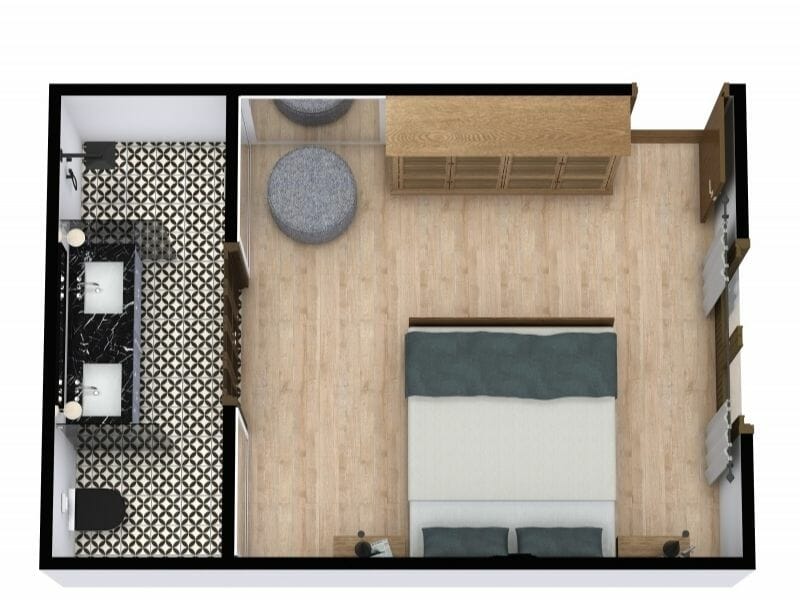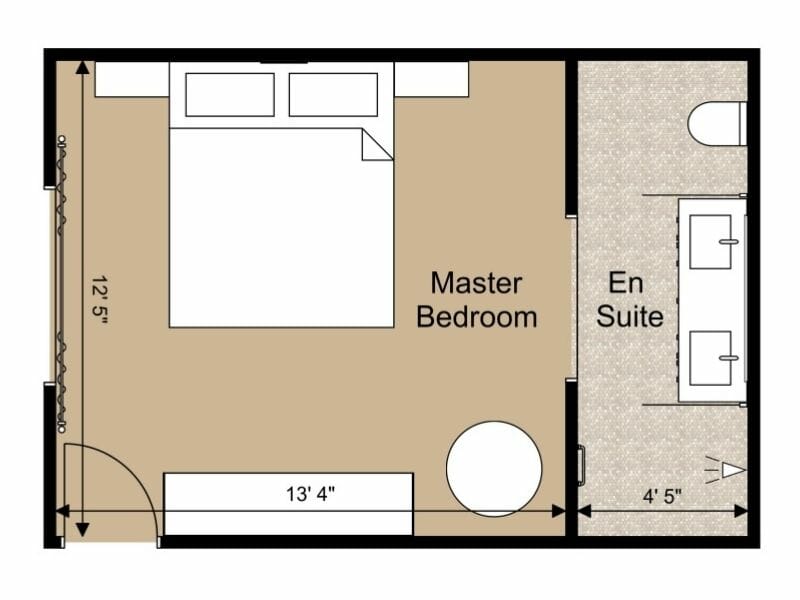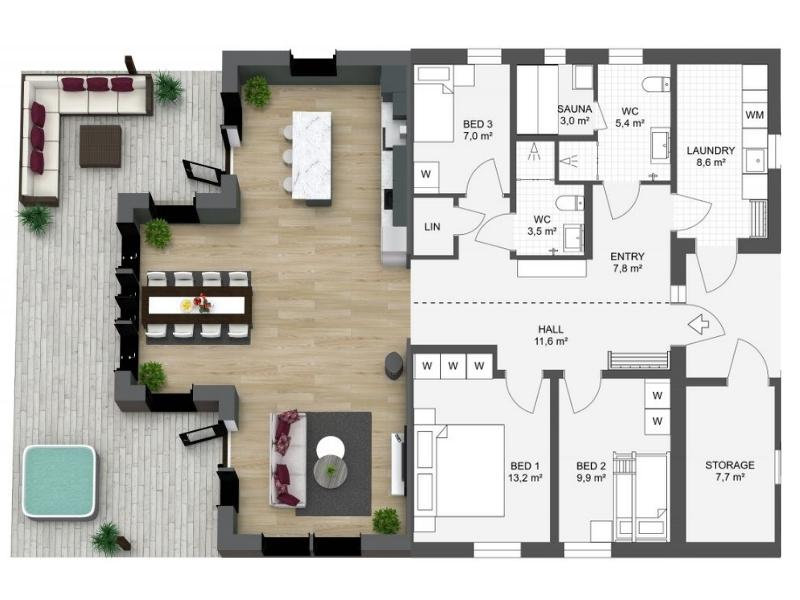How to Design a Bedroom Layout: 8 Tips to Consider
Designing the perfect bedroom layout can seem tricky at first, but with the right questions and a bit of planning, it can become a fun and rewarding project. Here are eight practical tips to help you create a bedroom that suits your style and needs.

If you want to make the most of a small bedroom, create space for a work desk or design a cozy sitting area in your master suite. This article will help you ask and answer the important questions needed to plan the perfect bedroom and give you bedroom layout ideas.
1. What’s the Size?

Start with the bedroom dimensions for your floor plan. A king-sized bed cannot fit in a small 7'x10' (6m2) room and still be able to open the door.
Small bedrooms (around 10'x11'): Place a full- or queen-size bed along the longest wall, and use compact nightstands. Wall sconces are great for saving space.
Large primary suites (15'x20' or more): Create distinct zones — like a sleeping area with the bed and nightstands, and a cozy seating nook near a window.
The shape of the room matters, too. A square room offers easy symmetry. Typically, place your bed against the wall opposite the door, with nightstands on either side. In a long, narrow bedroom, place the bed against one of the short walls. Then, set up a seating area across from it.
What Is an Average Size Bedroom?
The average US bedroom is about 132 sq. ft. (11'x12' or 3.3m by 3.6m), which provides enough space for a queen-sized bed and a small wardrobe.
2. How Will I Use It?

Before you begin your layout, consider how you will use the bedroom. This is key to designing a good layout.
- To watch TV comfortably, place the TV where you can easily see it from your bed. The best spots are right across from your bed or next to it.
- If you want to work in your bedroom or use it as a home office, choose a layout that includes storage around your desk.
- If you are a reader, your design should include reading lights for the bed or comfortable chairs in a reading nook.
- If you are only going to sleep in the room, arrange the layout so that the bed is as far away as possible from noisy or drafty spots.
- The layout for a small kid's room for one young child might include a twin bed and play space, while a room for two older kids might need a bunk bed and two desks.
- If you have pets, make sure there's space for them in your layout, especially if they're St. Bernard dogs with big beds.
It's generally not a good idea to place a full- or queen-sized bed in a corner. However, if you live alone, this layout might create space for the reading nook you want.
3. What Are the Architectural Elements?

When planning your bedroom layout, be sure to include key architectural features like windows, doors, closets, and any ensuite bathrooms. If you have a fireplace with a surround or mantel, map that out too so you can highlight it in your design.
Don’t forget to consider ceiling elements. Whether you have beams or a vaulted ceiling, you might want to position your bed to draw attention to these beautiful details.
It’s also a good idea to add practical elements to your floor plan. Mark where electrical plugs, heating vents, and door swings go. For example, if your door is 36 inches (90 cm) wide—which is the standard width—you’ll need to allow for a three-foot (90 cm) swing to avoid furniture placement issues.
4. Where Should I Place the Bed?

As the most significant piece of furniture in your room, your bed will naturally be the room's focal point. Often, the best place to put your bed is along the longest wall. It's a good idea to place your bed symmetrically to create a peaceful bedroom.
Sometimes, it's easy to achieve symmetry by placing the bed between two windows, two columns, or built-in shelves. You can also achieve symmetry by matching a large, decorative bed with an armoire.
5. What's the View Like?

Visualize the view from the bed:
- Do you want to take in the scenery outside the window when you wake up?
- Do you have the luxury of a fabulous view of the ocean, mountains, or the city skyline that you don't want to block?
- Can you see the fireplace from your bed?
Sometimes placing the bed in front of a window which does not offer a view is a good choice.
Also, consider what you see when you enter the bedroom. The foot of the bed is often the first thing you see when you walk in the door. Does that make the most sense for your space?
6. How Should I Arrange the Furniture?

To arrange furniture in a bedroom, keep it simple and tidy, avoiding unnecessary pieces.
Start with a list of what you need. If you have sufficient closet space, you may not need a bulky dresser. If you're short on space, a small table that doubles as a small workspace may be better than a nightstand.
Consider your zones

A good idea is to "zone out" - think of the bedroom in terms of zones, then furnish accordingly. That way, you make sure to cover your needs, without over-furnishing.
7. Do I Have Clear Pathways and Good Flow?
When designing a bedroom layout, keep in mind the rule of thumb of having a minimum of two feet to walk around your bed. Keep your bed accessible from both sides, especially if sharing the space with your partner.
Also, make sure not to block natural pathways through your bedroom, especially to the bathroom. Make it easy to walk from place to place.
If you want to create a peaceful and happy bedroom for better sleep, consider using Feng Shui. This ancient Chinese practice offers simple tips that can help improve your space. Whether you are a Feng Shui expert or just curious, these ideas are worth exploring.
Feng Shui in the bedroom includes these important principles:
- Keep the space clean and uncluttered
- Place the bed diagonally across from the door
- Use a wooden headboard
- Choose soft neutral colors for your decor
- Be mindful of where you place the mirror
🪞Feng Shui Mirror Placement:
"Strategically place mirrors to enhance the bedroom's aesthetics and functionality. Mirrors can reflect light and make the room appear more spacious. Consider a full-length mirror on the closet door or a decorative mirror above the dresser. Be mindful of the mirror's placement to avoid undesirable reflections, such as facing the bed, which some people find unsettling during sleep."
-Victor Cheung, Feng Shui Nexus
8. What’s the Mood I Want to Create?

We spend a disproportionate amount of time in our bedrooms, and most of us consider the space an oasis. But that has different meanings for each of us.
Minimize clutter and maximize modern, organic elements to create a Zen-like feeling. Pick a tufted headboard, floral fabrics, and traditional furniture for a cozier space. Use brighter, bolder colors, and don't be afraid to mix patterns if you want a more eclectic look.
Our bedroom spaces are as individual as each of us. Create a mood and style that resonates with you and suits your lifestyle. To get more inspiration, you can check out our Floor Plan Gallery.

Use a Floor Plan Software to Design Your New Bedroom Layout
Using floor plan software to create a bedroom layout will help you make the best layout for your room without moving furniture around.
Visualizing the new materials can also be helpful if you make larger changes, such as painting your walls or changing flooring.
Recommended Reads

How to Visualize a Room Using an Interior Design Visualizer
Bring your interior design ideas to life with RoomSketcher. Create room designs, floor plans, and visualize your ideas in stunning 3D.

How to Create an Impressive Bedroom Design Online
Create your bedroom design online and browse our bedroom layout ideas. Practical design advice to get you started.

The 8 Best Floor Plan Software Tools
The market is flooded with floor plan software options, each promising to make your processes easier and more efficient. We've put the top tools to the test!